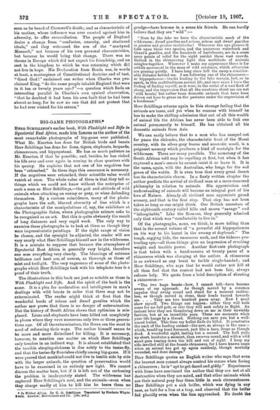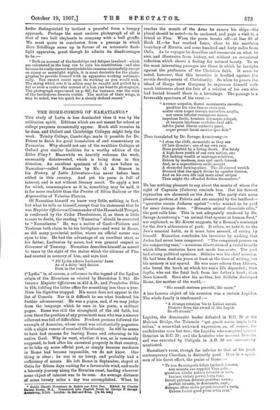BIG-GAME PHOTOGRAPHS.*
HERR SCHILLINGS'S earlier book, With Flashlight and Rifle in Equatorial East Africa, made him famous as the author of the most remarkable photographs of big-game ever published. What Mr. Kearton has done for British birds and beasts Herr Schillings has done for lions, tigers, elephants, leopards, rhinoceroses, and hippopotami. He has as much patience as Mr. Kearton, if that be possible; and, besides, he has risked his life over and over again in coming to close quarters with his quarry. He explains that not one of his negatives has been "retouched?' In these days this assurance is necessary. If the negatives were retouched, their scientific value would vanish at once. The whole value of them is that they tell us things which we could not know without the enterprise of such a man as Herr Schillings,--the gait and attitude of wild animals when attacking an enemy or prey, or when defending themselves. By a curious coincidence, many of the photo- graphs have the soft, blurred obscurity of line which is a characteristic of the manipulations of, say, the exhibitors at the Photographic Salon, where photographic science asks to be recognised as an art. But this is quite obviously the result of long distances and very rapid work. The only way to examine these photographs is to look at them as though they were impressionistic) paintings. - If the right range of vision be chosen, and the eyesight be adjusted, the reader will see very nearly what Herr Schillings himself saw in the wilderness. It is a mistake to suppose that because the atmosphere of Equatorial East Africa is generally very bright, therefore one sees everything very clearly. The blurrings of extreme brilliance and heat are, of course, as thorough as those of mist and twilight. The very vagueness of some of the photo- graphs which Herr &billings took with his telephoto lens is a proof of their truth.
The illustrations in this book are just as notable as those in With Flashlight and Rifle. And the spirit of the book is the same. It is a plea for moderation and intelligence in man's dealings with wild beasts in order that these may not be exterminated. The reader might think at first that the wonderful herds of zebras and dwarf gazelles which the author saw prove that there is no danger of extermination. But the history of South Africa shows that optimism is mis- placed. Lions and elephants have been killed out completely in places where they were numerous only two or three genera- tions ago. Of all the exterminators, the Boers are the most in need of reforming their ways. The author himself seems to be more and more disinclined for killing. It is necessary, however, to mention one matter on which Herr Schillings only touches in an indirect way. It is almost established that the terrible sleeping-sicknesa is due solely to the tsetse-fly, and that the tsetse-fly flourishes chiefly among big-game. If it were proved that mankind could not live in health side by side with the larger animals, the question of preservation would have to be examined in an entirely new light. We cannot discuss the matter here, but if it is left out of the reckoning the problem is inadequately stated. The wilderness has captured Herr Schillings's soul, and the animals—even when they charge madly at him to kill him he bears them no • In Snidest Africa. By C. G. Schilling& Translated by Frederic 'Whyte. Simla. London Hutchinson and Co. (24n net.]
grudge—have become in a sense his friends. He can hardly believe that they are " wild " :-
,' Here by the lake we have tho characteristic mark of the wilderness: dwarf gazelles and zebras, zebras and dwarf gazelles in greater and greater multitudes! Wherever the eye glances it falls upon these two species, and the numerous waterbuck and Grant's gazelles, and the hundreds of hartebeests, are in a sense mere points of relief for the sight amidst these vast crowds. Bathed in the shimmering light this multitude of animals mingles together. Wherever I make my appearance there is for awhile movement in the mass of wild creatures, which otherwise are grazing quietly. I have long since left the camp a consider- able distance behind me. I am following one of the rhinoceros— or hippopotamus—tracks leading to the lake margin, lost, so to speak, in this multitudinous animal life, and once m9ro I have the feeling of finding myself, as it were, in the midst of a vast flock of sheep, and the impression that all the creatures about me are not 'wild beasts,' but rather tame domestic animals that have been driven out here to graze on the pastures under the supervision of a herdsman."
Herr Schillings returns again to this strange feeling that the animals are tame, and yet when he reasons with himself he has to make the chilling admission that out of all this wealth of animal life the African has never been able to link one animal permanently to himself. He has obtained all his domestic animals from Asia.
We can easily believe that to a man who has camped out for years the elelescho, the characteristic bush of the Masai country, with its silver-grey leaves and aromatic smell, is a
poignant memory which produces a kind of nostalgia for the wilderness. There are many parallels. The monotony of the South African veld may be repelling at first, but when it has
captured a man's senses be cannot resist it or leave it. It is . the same, again, with the Australian, who longs for the sad green of the wattle. It is even true that every great desert has its characteristic charm. In a finely written chapter the author predicts the arrival of civilised man at a more reasoned philosophy in relation to animals. His appreciation and understanding of animals will become an integral part of his love of Nature. Already all civilised men appreciate grand scenery, and that is the first step. That step has not been taken so long as one might think. Our British ancestors of the eighteenth century called hills and moors "savage" and "inhospitable." Like the Romans, they generally admired only that which was "comfortable to live in."
Of the photographs, none, we think, is more telling than that in the second volume of "a powerful old hippopotamus on his way to his haunt in the swamp at daybreak." The tough, sagging hide, the enormous neck, and the hideoueepro- truding eye,—all these things give an impression of crushing weight and terrible power. Another first-rate photograph is that taken with a hand-camera at twenty paces of a rhinoceros which was charging at the author. A rhinoceros is as awkward as any beast to tackle single-handed ; and Herr Schillings, who says that he would rather not kill at all than feel that the contest had not been fair, always refuses help. We quote from a brief description of shooting a rhinoceros :— "The two huge beasts—how, I cannot tell—have become aware of my approach. As though moved by a common impulse they swing round and stand for a moment motion- less, as though carved in stone, their heads turned towards me. . . • They are two hundred paces away. Now I must show myself. Two things can happen: either they will both come for me full pelt, or else they will seek safety in flight. An instant later they are thundering down on me in their unwieldy fashion, but at an incredible pace. These are moments when your life hangs by a thread. Nothing can save you but a well- aimed bullet. This time my bullet finds its billet. It penetrates the neck of the leading animal—the cow, as always is the case— which, tumbling head foremost, just like a hare, drops as though dead. A wonderful sight, lasting but a second. The bull pulls up short, hesitates a moment, then swerves round, and with a wild snort goes tearing down the hill and out of sight. I keep my rifle levelled still at the female rhinoceros, for I have known cases when an animal has got up again suddenly, though mortally wounded, and done damage."
Herr Schillings quotes an English writer who says that even the bravest man cannot always control his senses when facing a rhinoceros ; he is " apt to get dazed and giddy." Experiences with lions have convinced the author that they are not at all destructive when they are sated, and that other animals which are their natural prey fear them little in ouch circumstances. Herr Sohilling,s put a sick heifer, which was dying in any case, as bait for a lion at a trap, and observed that the heifer fed placidly even when the lion approached. No doubt the Leifer distinguished by instinct a peaceful from a hungry approach. Perhaps the most curious photograph of all is that of two bull elephants in company with a bull giraffe. We must quote in conclusion from a passage in which Herr Schillings sums up in favour of an automatic flash- light apparatus, great though he admits its disadvantages to be:—.
"Both on account of the hardships and fatigue involved—which are calculated in the long run to ruin his constitution—and also because he really cannot manipulate his cameras successfully except on starry or moonlight nights, it is most desirable for the photo- grapher to provide himself with an apparatus working automati- cally. You cannot count upon its working as you would wish. The string which sets it in action may be caught and pulled by a bat or even a cockchafer instead of a lion you want to photograph. The photograph reproduced on p. 697, for instance, was the work of the turtledoves therein visible. The motion of their wings, it may be noted, was too quick for a clearly defined record."











































 Previous page
Previous page